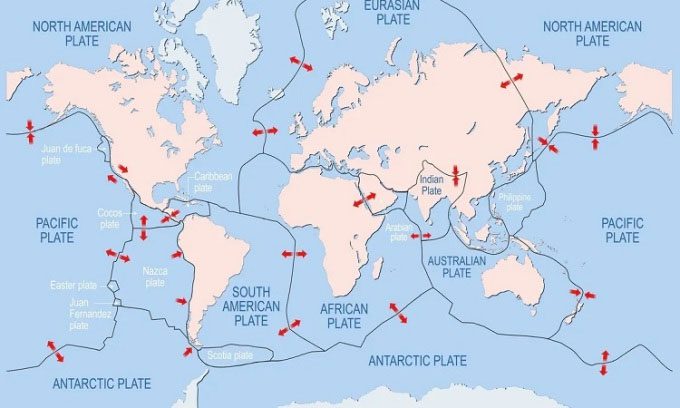The number of tectonic plates on Earth ranges from 10 to 100, and most of them do not even appear on official maps.
Billions of years ago, the surface of the Earth was a sea of molten rock. As the magma gradually cooled, it formed a seamless crust with denser minerals accumulating near the planet’s core and less dense minerals rising to the surface. According to Catherine Rychert, a geophysicist at the Woods Hole Oceanographic Institution in Massachusetts, this is how tectonic plates form at the Earth’s surface. Tectonic plates are the crust with a thin layer of mantle beneath them. Below this is weaker, hotter, and more mobile material. The difference in density between the two layers causes the upper layers to move, collide, merge, and push against each other. In these areas, faults and mountains form, leading to volcanic activity and earthquakes, which give rise to life.

Major and minor tectonic plates on the Earth’s surface. (Photo: iStock).
The number of tectonic plates covering the Earth’s surface ranges from over a dozen to nearly 100, depending on the classification criteria. Most researchers agree that there are 12 to 14 major tectonic plates that cover most of the Earth’s surface, according to Saskia Goes, a geologist at Imperial College London. Each plate has an area of at least 20 million km2, with the largest being the North American, African, Eurasian, Indo-Australian, South American, Antarctic, and Pacific plates. The largest of these is the Pacific Plate, covering 103.3 million km2, followed by the North American Plate at 75.9 million km2.
According to Goes, in addition to the 7 major tectonic plates, there are 5 smaller plates including the Philippine Sea Plate, Cocos Plate, Nazca Plate, Arabian Plate, and Juan de Fuca Plate. Some geologists consider the Anatolian Plate (part of the larger Eurasian Plate) and the East African Plate (part of the African Plate) as separate entities because they move at significantly different rates than the major plates. This is why the number of major tectonic plates is estimated to be between 12 and 14.
The situation becomes more complex when considering tectonic plate boundaries, where they divide into smaller plates known as microplates. Microplates are regions less than one million km2 in area. Some scientists estimate that there are about 57 microplates on Earth. However, they are often not represented on world maps. “The number of microplates continuously changes, depending on how scientists define them and the deformation at tectonic plate boundaries,” explains Goes.
The movement of tectonic plates on Earth creates several notable formations. The Pacific Plate may be the fastest-moving plate, shifting northwest at a rate of 7 to 10 cm per year. Its rapid movement results from the surrounding subduction zones, also known as the Ring of Fire, where gravitational forces pull the tectonic plate toward the Earth’s center.


















































